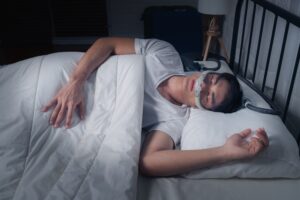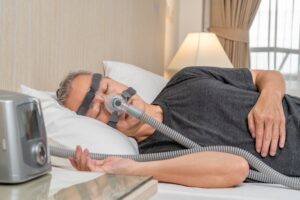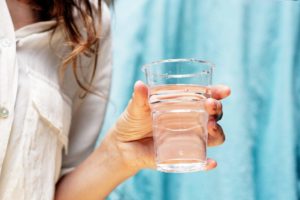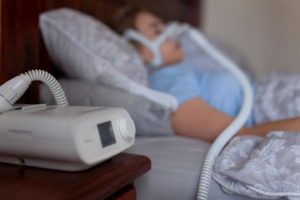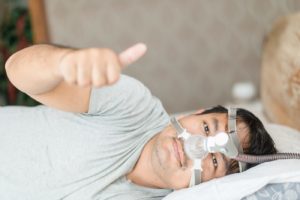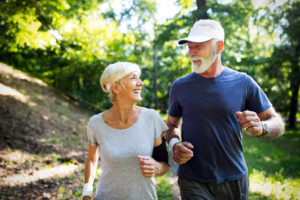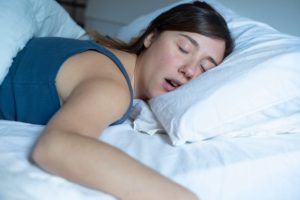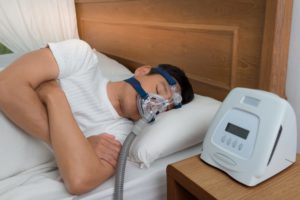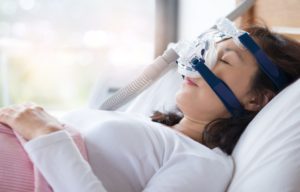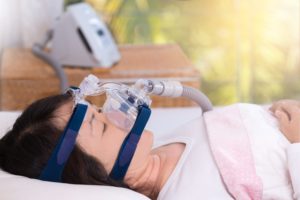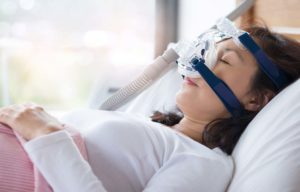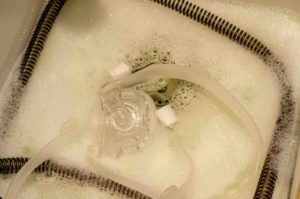When you buy through our links, we may earn a commission. Products or services may be offered by an affiliated entity. Learn more.
CPAP and COVID-19
Continuous positive airway pressure (CPAP) therapy is one of the most effective treatments for obstructive sleep apnea (OSA), a sleep-related breathing disorder. CPAP therapy uses a device that delivers a steady stream of pressurized air through the nose or mouth to keep the airway open and prevent breathing disruptions.
Both COVID-19 and OSA affect breathing, so it’s natural for questions to arise about how using a CPAP affects the risks of COVID-19 infection, whether CPAP can be used to treat the complications of COVID-19, and how people with OSA can safely use their CPAP during the pandemic.
Suspect You May Have Sleep Apnea?
Answer three questions to understand if you should be concerned.
Sleep Apnea and COVID-19
Research has found that people with obstructive sleep apnea have an increased risk of contracting COVID-19 . People with OSA may be more likely to be hospitalized if they get COVID-19. Some research also suggests that, once hospitalized, people with OSA are more likely to be admitted to an intensive care unit (ICU) .
Fortunately, using CPAP therapy as directed by a doctor is associated with lower rates of COVID-19 in people with OSA. Adherence to CPAP therapy generally requires using the device for at least four hours per night no less than five nights per week, though even those who only use their CPAP device for a few hours per night may have a lower risk of infection than those who do not use CPAP therapy at all.
CPAP as a Treatment for COVID-19
CPAP therapy has emerged as a treatment option for improving oxygen levels in some people with COVID-19 regardless of whether they have obstructive sleep apnea.
COVID-19 can affect lung function. Many people who are admitted to the hospital with the disease have low levels of oxygen in their blood, a condition called respiratory failure. When this occurs, doctors have several options for trying to improve blood oxygen levels.
Using a mechanical ventilator involves intubating a person by inserting a plastic tube into their windpipe and having a machine move air into and out of their lungs. This is an invasive treatment, and the risks of complications means that it is not the best option for everyone who needs supplemental oxygen. In addition, mechanical ventilation requires specific equipment, which was a concern at the beginning of the pandemic when ICU beds were limited. As a result, doctors have explored the use of CPAP therapy and other non-invasive treatments to address low oxygen levels caused by COVID-19.
After early reports of success, doctors began using CPAP therapy as an initial treatment for respiratory failure in some people with COVID-19. One small study found that CPAP was successful at raising oxygen levels among people who were hospitalized with COVID-19. Additional studies have found similar benefits to CPAP as a non-invasive treatment for respiratory failure. For some patients, initial use of CPAP therapy may prevent the need for intubation.
However, further investigation is needed to fully understand the benefits and downsides of CPAP therapy as a treatment for complications of COVID-19. Some research found that CPAP provided no added benefit in people who were not eligible for intubation. Additionally, treatments like oxygen therapy , which delivers oxygen through a face mask or small tubes placed in the nostrils, may offer similar benefits to CPAP therapy. It is difficult to draw conclusions from existing research about how CPAP use compares to oxygen therapy and other non-invasive treatments.
Not everyone with COVID-19 is a good candidate for CPAP therapy. Some studies found CPAP therapy to have lower effectiveness in older adults and people with more significant respiratory failure. Around half of people may ultimately require intubation despite CPAP therapy. For these people, delaying intubation may actually worsen their lung injury and increase the risk of death from COVID-19. Additionally, some people have issues continuing CPAP therapy because of feelings of claustrophobia, anxiety, or discomfort when wearing a CPAP mask.
Given the rapidly developing knowledge about COVID-19 and its treatment, researchers are still seeking out ways to make CPAP therapy more effective and identify people who are most likely to benefit from using it. For example, one study found that lying face down while awake when using a CPAP reduced the effort required to breathe and improved oxygen levels among people with respiratory problems from COVID-19.
CPAP Machines vs. Ventilators
A CPAP machine is a non-invasive way of providing breathing support to people with lung problems. A CPAP works by sending a constant stream of pressurized air through a mask and into the airway, which helps deliver oxygen contained in air to the lungs.
In contrast, a ventilator is a device that mechanically controls breathing for a person who otherwise cannot obtain enough oxygen. Ventilation requires placing a tube in the windpipe , also known as the trachea. This tube is connected to a machine that regulates breathing, which in many cases is a life-saving treatment. However, ventilators can increase the risk of lung injury, infection, and other unwanted side effects.
Non-invasive ways of providing breathing support like CPAP therapy may be used as a first-line treatment for people with certain lung conditions who either do not require or cannot tolerate invasive mechanical ventilation. Research supports the idea that certain people with COVID-19 may benefit by starting with non-invasive therapy instead of mechanical ventilation.
Is It Safe to Continue Using a CPAP if You Have Symptoms or Test Positive for COVID-19?
In most cases, it is safe for people with sleep apnea to keep using their CPAP device even if they have COVID-19. That said, if you have symptoms or have tested positive for COVID-19, you should talk with your health care provider about whether to continue using your CPAP machine for OSA.
Using a CPAP as directed by a doctor can enable steadier breathing and improve sleep quality in people with OSA. Getting good sleep can help the immune system function properly. In addition, suddenly stopping CPAP therapy for a period of weeks may raise blood pressure and heart rate.
Whether or not to continue using a CPAP is a decision you can make with your doctor based on the severity of your OSA and other factors related to your overall health.
Frequently Asked Questions About CPAP and COVID-19
Can a CPAP Spread COVID-19 to Others?
There is little evidence that using a CPAP can spread COVID-19 any more than
breathing, speaking, or coughing
.
Some people may be worried about a CPAP machine spreading viral particles. CPAP machines are designed to let the person exhale carbon dioxide, so they may release aerosols into the air that could contain viral particles.
Doctors and CPAP users have expressed concern that using a CPAP could increase exposure to the SARS-CoV-2 virus that causes COVID-19. Fortunately, evidence suggests that CPAP use does not cause significant
spread of the virus
in the air or on surfaces.
Nevertheless, CPAP users who have COVID-19 should consider sleeping in a separate bedroom to reduce exposure of household members to viral particles that could be generated by the CPAP or by their normal breathing or coughing.
In a hospital setting, a
helmet CPAP
may be used. This device involves placing a helmet over the patient’s head to reduce the potential risks of aerosols created by a traditional CPAP.
How Often Should You Clean Your CPAP and Mask?
You should clean your CPAP machine and mask
according to the instructions
for your specific device. While directions may vary, the guidance is generally as follows:
– Daily: Clean the tube, mask, and humidifier reservoir. Use warm, mild soapy water and then rinse and air dry.
– Weekly: Disinfect the tube, mask, and humidifier reservoir. Follow manufacturer instructions to properly disinfect these without damaging the equipment.
When you are sick, whether with COVID-19 or another illness, you may want to clean and disinfect your CPAP on a daily basis. The Centers for Disease Control and Prevention (CDC) recommends that people with COVID-19 regularly
disinfect surfaces
they touch frequently in their home as well as any surfaces that could have bodily fluids on them, such as a CPAP mask.
What to Do if You Use a CPAP and Suspect You Have COVID-19
If you use a CPAP machine and think you may have COVID-19, follow this guidance from the CDC:
– Get tested as soon as possible: You can use an at-home COVID test or get tested at a local pharmacy or testing site near you.
– Call your doctor: People with OSA may be at greater risk of severe COVID-19, so talk to your primary care provider as soon as you test positive. They can discuss treatment and next steps, including any symptoms to watch for.
– Isolate yourself: Once you notice symptoms, isolate yourself from others, including people and pets in your household. Sleep in a separate bedroom and use a separate bathroom if possible.
– Tell anyone that may have been exposed: Tell anyone you have been in close contact with over the past 48 hours that they may have been exposed to COVID-19 so they can get tested.
– Wash your hands frequently: Wash your hands with soap and water regularly, including before you put your CPAP mask on at night.
– Improve ventilation at home: Keep the door to your bedroom shut but open windows throughout your home to improve air flow.
– Focus on good sleep: Getting good sleep is important when you are sick, including if you become infected with COVID-19.
When Should You Talk to a Doctor?
Talk to your doctor if you have any questions about your CPAP therapy when you are sick with COVID-19. If you start to notice any severe symptoms, such as difficulty breathing, chest pain, confusion, trouble staying awake, or changes in skin tone, call 911 or go to an emergency medical care facility immediately.

Still have questions? Ask our community!
Join our Sleep Care Community — a trusted hub of product specialists, sleep health professionals, and people just like you. Whether you’re searching for the perfect mattress or need expert sleep advice, we’ve got you covered. Get personalized guidance from the experts who know sleep best.
References
18 Sources
-
Hwang, D., Chen, A., Arguelles, J., Kim, J., Becker, K., Woodrum, R., Benjafield, A., Cole, K., & Shi, J. (2021). 680 impact of obstructive sleep apnea and positive airway pressure therapy on COVID-19 outcomes. Sleep, 44(Suppl 2), A266.
https://www.ncbi.nlm.nih.gov/pmc/articles/PMC8135581/ -
Strausz, S., Kiiskinen, T., Broberg, M., Ruotsalainen, S., Koskela, J., Bachour, A., FinnGen, Palotie, A., Palotie, T., Ripatti, S., & Ollila, H. M. (2021). Sleep apnoea is a risk factor for severe COVID-19. BMJ open respiratory research, 8(1), e000845.
https://pubmed.ncbi.nlm.nih.gov/33436406/ -
Mello, M. T., Silva, A., Guerreiro, R. C., da-Silva, F. R., Esteves, A. M., Poyares, D., Piovezan, R., Treptow, E., Starling, M., Rosa, D. S., Pires, G. N., Andersen, M. L., & Tufik, S. (2020). Sleep and COVID-19: Considerations about immunity, pathophysiology, and treatment. Sleep Science (Sao Paulo, Brazil), 13(3), 199–209.
https://pubmed.ncbi.nlm.nih.gov/33381288/ -
Demirovic, S., Lusic Kalcina, L., Pavlinac Dodig, I., Pecotic, R., Valic, M., Ivkovic, N., & Dogas, Z. (2021). The COVID-19 lockdown and CPAP adherence: The more vulnerable ones less likely to improve adherence?. Nature and Science of Sleep, 13, 1097–1108.
https://pubmed.ncbi.nlm.nih.gov/34290535/ -
Anesi, G. L. (2022, February 16). COVID-19: Respiratory care of the nonintubated hypoxemic adult (supplemental oxygen, noninvasive ventilation, and intubation). UpToDate., Retrieved March 18, 2022, from
https://www.uptodate.com/contents/covid-19-respiratory-care-of-the-nonintubated-hypoxemic-adult-supplemental-oxygen-noninvasive-ventilation-and-intubation -
Patel, B. K. (2020, April). Mechanical ventilation. Merck Manual Consumer Version., Retrieved March 18, 2022, from
https://www.merckmanuals.com/home/lung-and-airway-disorders/respiratory-failure-and-acute-respiratory-distress-syndrome/mechanical-ventilation -
Vaschetto, R., Barone-Adesi, F., Racca, F., Pissaia, C., Maestrone, C., Colombo, D., Olivieri, C., De Vita, N., Santangelo, E., Scotti, L., Castello, L., Cena, T., Taverna, M., Grillenzoni, L., Moschella, M. A., Airoldi, G., Borrè, S., Mojoli, F., Della Corte, F., … Cammarota, G. (2021). Outcomes of COVID-19 patients treated with continuous positive airway pressure outside the intensive care unit. ERJ Open Research, 7(1), 00541-2020.
https://pubmed.ncbi.nlm.nih.gov/33527074/ -
Aung, H., Avraam, E., Ashraf, M., Karim, N., Kiran, S., Naeem, M., Mallik, S., Panchatsharam, S., Tsaknis, G., & Reddy, R. (2021). Outcomes of continuous positive airway pressure in the management of patients with coronavirus (COVID-19) pneumonia who are not suitable for invasive ventilation. The Open Respiratory Medicine Journal, 15, 23–27.
https://pubmed.ncbi.nlm.nih.gov/34249179/ -
Bradley, P., Wilson, J., Taylor, R., Nixon, J., Redfern, J., Whittemore, P., Gaddah, M., Kavuri, K., Haley, A., Denny, P., Withers, C., Robey, R. C., Logue, C., Dahanayake, N., Min, D., Coles, J., Deshmukh, M. S., Ritchie, S., Malik, M., … Pearmain, L. (2021). Conventional oxygen therapy versus CPAP as a ceiling of care in ward-based patients with COVID-19: a multi-centre cohort evaluation. EClinicalMedicine, 40, 101122.
https://pubmed.ncbi.nlm.nih.gov/34514360/ -
Radovanovic, D., Coppola, S., Franceschi, E., Gervasoni, F., Duscio, E., Chiumello, D. A., & Santus, P. (2021). Mortality and clinical outcomes in patients with COVID-19 pneumonia treated with non-invasive respiratory support: A rapid review. Journal of Critical Care, 65, 1–8.
https://pubmed.ncbi.nlm.nih.gov/34052780/ -
Chiumello, D., Chiodaroli, E., Coppola, S., Cappio Borlino, S., Granata, C., Pitimada, M., & Wendel Garcia, P. D. (2021). Awake prone position reduces work of breathing in patients with COVID-19 ARDS supported by CPAP. Annals of Intensive Care, 11(1), 179.
https://pubmed.ncbi.nlm.nih.gov/34928455/ -
Popat, B., & Jones, A. T. (2016). Invasive and non-invasive mechanical ventilation. Medicine (Abingdon, England: UK ed.), 44(6), 346–350.
https://pubmed.ncbi.nlm.nih.gov/32288578/ -
Yang, M. C., Huang, Y. C., Lan, C. C., Wu, Y. K., & Huang, K. F. (2015). Beneficial effects of long-term CPAP treatment on sleep quality and blood pressure in adherent subjects with obstructive sleep apnea. Respiratory Care, 60(12), 1810–1818.
https://pubmed.ncbi.nlm.nih.gov/26396261/ -
Hamilton, F. W., Gregson, F., Arnold, D. T., Sheikh, S., Ward, K., Brown, J., Moran, E., White, C., Morley, A. J., AERATOR Group, Bzdek, B. R., Reid, J. P., Maskell, N. A., & Dodd, J. W. (2022). Aerosol emission from the respiratory tract: an analysis of aerosol generation from oxygen delivery systems. Thorax, 77(3), 276–282.
https://pubmed.ncbi.nlm.nih.gov/34737195/ -
Winslow, R. L., Zhou, J., Windle, E. F., Nur, I., Lall, R., Ji, C., Millar, J. E., Dark, P. M., Naisbitt, J., Simonds, A., Dunning, J., Barclay, W., Baillie, J. K., Perkins, G. D., Semple, M. G., McAuley, D. F., & Green, C. A. (2022). SARS-CoV-2 environmental contamination from hospitalised patients with COVID-19 receiving aerosol-generating procedures. Thorax, 77(3), 259–267.
https://pubmed.ncbi.nlm.nih.gov/34737194/ -
Amirfarzan, H., Cereda, M., Gaulton, T. G., Leissner, K. B., Cortegiani, A., Schumann, R., & Gregoretti, C. (2021). Use of helmet CPAP in COVID-19 – A practical review. Pulmonology, 27(5), 413–422.
https://pubmed.ncbi.nlm.nih.gov/33583765/ -
Mercieca, L., Pullicino, R., Camilleri, K., Abela, R., Mangion, S. A., Cassar, J., Zammit, M., Gatt, C., Deguara, C., Barbara, C., Fsadni, P., & Montefort, S. (2017). Continuous positive airway pressure: Is it a route for infection in those with obstructive sleep apnoea?. Sleep Science (Sao Paulo, Brazil), 10(1), 28–34.
https://pubmed.ncbi.nlm.nih.gov/28966735/ -
National Center for Immunization and Respiratory Diseases (NCIRD), Division of Viral Diseases. (2022, February 7). What to do if you are sick., Retrieved March 3, 2022, from
https://www.cdc.gov/coronavirus/2019-ncov/if-you-are-sick/steps-when-sick.html






